Note from the Author: The enigmatic Kolbrin contains alongside its Celtic records six ancient Egyptian books, the remnants of scrolls written or copied by scribes from much earlier writings whose provenance has not yet been proven. Most people dismiss the books as forgeries. I am convinced that their core material is genuine.
What is a human being? ‘It’s animal and it’s noble,’ said the actor-writer Stephen Fry on air some years ago 1. Where that ‘noble animal’ comes from is perhaps the biggest question of all. Neanderthals, Denisovans, Homo naledi2, Homo luzonensis3 – the surprises keep coming and the mystery deepens. Over recent decades, discoveries have sent mainstream thinking into flux – particularly the latest finding that two million years ago, three different human-like species were living side-by-side in South Africa: Australopithecus (made famous by the ‘Lucy’ fossil from Ethiopia), Paranthropus and Homo sapiens4.
Several major theories of human origin bubble away in our belief systems: Creationism, Evolution and, most recently in fringe circles, human engineering by advanced beings or aliens5. Where do the mysterious books of the Kolbrin stand in this debate? Its Egyptian Books of Creation and Gleanings touch on two of the theories and substantiate a third, but they go further – they tell a story not found in any other source—the over-arching tragedy of why human beings are not what we were intended to be.
Creation by an Intelligent Designer
Christians who read the Book of Genesis literally believe the world was created by God in six days, and that he rested on the seventh.6 Some Christians have put forward the idea of an ‘Intelligent Designer’ as an alternative to the science of evolution. To many sceptical modern minds, creation by God seems a dated and difficult notion.
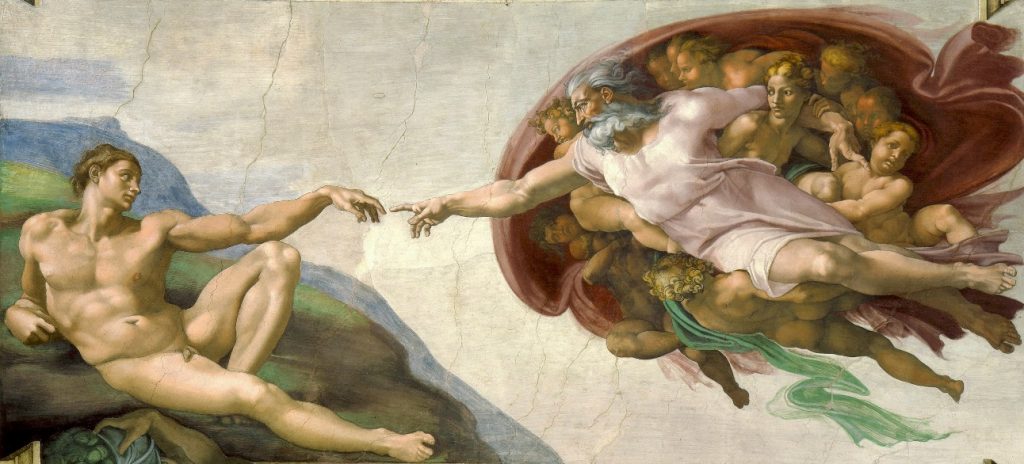
The Creation of Adam (detail), Michelangelo (1475-1564), Sistine Chapel, Rome (PD0)
What do the Kolbrin’s Egyptian books say vis à vis Creationism? Its opening chapter begins, ‘There are no true beginnings on Earth, for here all is effect, the ultimate cause being elsewhere… Before the beginning there was only one consciousness, that of the Eternal One…. It was the One Sole Spirit, the Self Generator which cannot diminish, the Unknown, Unknowable One brooding solitary in profound pregnant silence… Into the solitude of timelessness came Divine Loneliness and from this arose the desire to create… He took thought and brought into being within Himself the Universal Womb of Creation containing the everlasting essence… From the Great Womb had sprung the Spirit of Life and it was rampant in the Heavens. It gazed upon Earth and… and was filled with desire, and came out of the heavenly spaces to possess her. It came not peacefully as a lover, but tempestuously as a ravager. Its breath howled along her corridors and raged among her mountain tops…’ From these turbulent metaphorical beginnings the Great Womb moves on to create flora and fauna, ‘fishes and creatures which move about and twist themselves and wriggle in the waters, the serpents and the beasts of terrible aspect which were of yore, and reptiles which creep and crawl. There were tall walking things and dragons in hideous form clothed with terror, whose great bones may still be seen.’
Then, as Man slept, ‘God opened the Great Eye within him and man saw a vision of unsurpassed glory… Unbounded wisdom filled his heart and he beheld beauty in perfection. The ultimates of Truth and Justice were unveiled… The… ages of time unrolled … and he saw written thereon all that was to become and occur. The great vaults of Heaven were opened up unto him… He… was then even as God Himself, and he knew the secret of the Seven Spheres within Three Spheres. Then… the great vision departed and he awoke… no more than the shadow of a dream remained… Henceforth, man was destined to wander discontented, seeking something which told him that the radiance seen on the horizon but dimly reflected the hidden glory beyond it. Man awoke, the revelation… gone, only the grim reality of Earth’s untamed vastness surrounded him. But… He was now a new man… He looked above and saw glory in the Heavens. He saw beauty about him and he knew… things not of the Earth. The vision of eternal values arose before his inner eye. His Spirit was responding to its environment, man was now man, truly man.’7
From these profoundly mystic passages it emerges that the Kolbrin’s God is a far more abstract, conceptual divinity than the almighty God of the Book of Genesis.
Evolution
All species are descended from common ancestors8 according to the great naturalist, geologist and biologist Charles Darwin9. In recent years mainstream science has tended to see evolution as a branching process rather than clinging to his ‘Missing link’ theory. Those common ancestors are getting older all the time. Currently a partial skull found in the southern Peloponnese in Greece has been given an age of 210,000 years10, while recent remains from Morocco have been dated to 315,000 years ago11. But even looking at these great time periods, the nagging problem about evolutionary thinking is that there simply has not been enough time for the extraordinary changes that distinguish modern Homo sapiens from primitive humanoid species to have taken place, to have evolved. The anthropologist Agustin Fuentes describes those changes as no less than a transformation:12
‘The human baseline of creative cooperation, the ability to think, communicate, and collaborate with increasing prowess, transformed us into beings who invented the technologies that support domestication, economies, large-scale societies, warfare, and broad-scale peace. This collaborative and imaginative capacity for creativity also drove the development of religious beliefs and ethical systems, and even the production of artwork…’
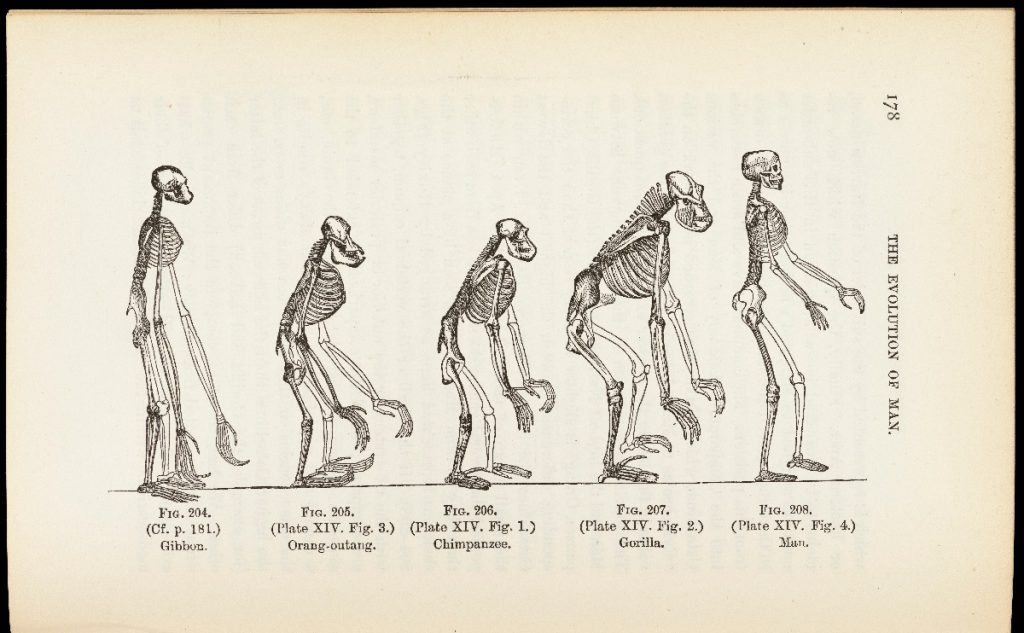
Illustration from The evolution of man: a popular exposition of the principal points
of human ontogeny and phylogeny, Ernst Haeckel (1834-1919) (PD0)
What does the Kolbrin say about mankind and evolution? The Book of Creation states that ‘Man, when young, lived only to eat and drink and to fornicate, for, being conscious only of the Earth, he knew only earthly things and earthly ways’. This suggests a primitive hominid slowly evolving.
Heavenman and Selok
Then, almost out of nowhere, comes a jaw-dropping paragraph:
‘Consider that which was told by the servants of Eban13, of Heavenman who once wandered the Earth. He had no earthly substance and could not grasp its fruits, for he had no hands. He could not drink its waters, for he had no mouth, nor could he feel the cool winds upon his skin. They tell how the ape tribe Selok, led by Heavenman, perished by flames before the Valley of Lod14, only one she-ape reaching the cave heights above. When Heavenman was reborn of the she-ape in the cavern of Woe15, could he taste the fruits of the Earth and drink of her waters, and feel the coolness of her winds? Did he not find life good? It is not all a tale of the courtyard!’16
The scribe’s comment, ‘It is not all a tale of the courtyard!’ indicates that this was not just scurrilous chitchat. And strangely enough, in 2014, two ancient skulls without mouths were reportedly discovered in a cave on Mount Bolshoi Tjach in Russia; the find was subsequently investigated by the scientist Vladimir Melikov and aired by the media two years later.17 Unfortunately, an entirely separate find in nearby woods of an old Nazi briefcase and a 1941 area map was immediately linked to the skulls and led to sensational paranormal speculations, after which the whole affair petered out. If these two skulls in Russia are indeed remnants of ‘Heavenman’, and there was another Heavenman in the Valley of Lod in Israel, then there would have been more than one Heavenman wandering the Earth in the distant past.
See images of mouthless skulls reportedly discovered in a cave on Mount Bolshoi Tjach, Russia here.
A later Kolbrin snippet echoes this event: ‘The first land on Earth wherein men dwelt was… a land out beyond the salt waters. To this land came the Immortal Spirit in the form of a Radiant One from Heaven, who had left his more enlightened place to dwell among beasts in the lower kingdom of sorrow. In some mysterious way he became incarnated as man, how we know not, but he founded the race of man.’18
The Kolbrin then swings back into more familiar mode, describing how Man, ’the child of calamity… the inheritor of a creative struggle’ was born ‘of upheaval and strife… All was in discord, snow fell in the hot wastelands, ice covered the fertile plains, the forests became seas…’ Later, ‘when he was grown sufficiently to be lifted so he walked in the uprightness of God’, Earth ‘raised him above all other creatures…’ The Kolbrin adds that although Man was ‘the son of Earth, the grandchild of God,’ he was ‘not her first-born’, but does not elaborate on this intriguing point.
The Children of God
After recording two global cataclysms which virtually destroy the Earth and its creatures, the Book of Creation describes a remarkable process:
‘Now, the Children of God were moulded by the Hand of God which is called Awen and it manifested according to their desires. For all things which have life are moulded by Awen. The fox, shivering in the coldlands, longs for warmth and so its cubs have warmer coats. The owl, clumsy in the dark, longs to see its prey more clearly, and in generations of longing the desire is granted. Awen makes everything what it is, for all things change under its law. Men, too, are moulded by their desires, but unlike the beasts and birds their yearnings are circumscribed by the laws of fate and destiny and the law of sowing and reaping’.19
‘Awen’ is obviusly evolution by another name20, a process by which ‘in generations of longing the desire is granted’. But mankind is rather different, says the Kolbrin: ‘their yearnings are circumscribed by the laws of fate and destiny.’ This raises the question: why are human beings different? Why did men and women not evolve like other creatures? More on this later.
Who were the ‘Children of God’? My article ‘The Kolbrin on the Sons of God and Daughters of Men’, 17th September 2018, sets out to tell the complex history of these obscure people; points touched on in that article are explored more fully here.
The Kolbrin tells us that the Sons and Daughters of God were special, very special indeed. Their story begins: ‘The forebears of all the nations of man were once one people, and they were the elect of God who delivered all the Earth over to them, all the people, the beasts of the field, the creatures of the wasteland and the things that grow. They dwelt through long ages in lands of peace and plenty. There were some who struggled harder, were more disciplined; because their forefathers had crossed the great dark void, their desires were turned Godward and they were called “The Children of God”’21
One phrase stands out: ‘Their forefathers had crossed the great dark void’. This ‘dark void’ can only be a cosmic void – a vast space between galaxy filaments in the universe22. But this was not just any void: it was ‘the great’ dark void. In 2013 astronomers identified the biggest of all voids discovered in modern times – the KBS Void which includes the Milky Way.23 Our Solar System lies within the KBS void. Could the Kolbrin be referring to this vast yawning emptiness?
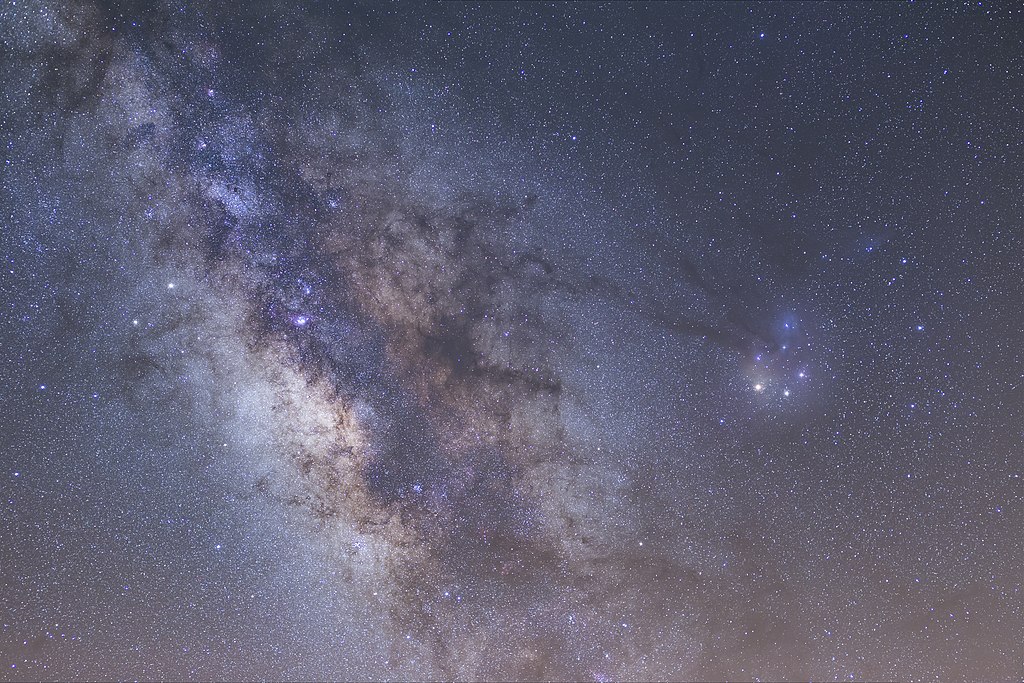
The Milky way and the Rho Ophiuchi star system photographed from 2,500 metres up a volcano in Tenerife.
‘Milky way nebula’ by AstroAnthony (CCBY4.0)
Later in the Book of Creation, a hominid says to a Child of God: ‘Back in the dreamingtime, when the Great Gods strove among themselves for dominion of the sky-spaces24… this land [Earth] was given to my people as their dominion, while yours was in another unearthly place far distant.25’ So the Children of God’s ancestors came from somewhere ‘unearthly’ and ‘far distant’, beyond Earth. The Book of Gleanings speaks of the Children of God at a later time when they became ‘fully Earth-sustained…’26 , indicating that previously they were partially sustained by a place that was not our Earth.
‘Time passed, and the Children of God were grown strong and upright…’27 It sounds as though destiny overtook evolution to produce some upright creatures who were capable of rather more than eating, drinking and fornicating, and those creatures were called the Children of God. The term ‘upright’ is significant here; the Kolbrin says that when man ‘was grown sufficiently to be lifted so he walked in the uprightness of God, [Earth] took him and raised him above all other creatures’; that ‘the Children of God were grown strong and upright under the tempering hammer of God’; and that ‘Then came man who walked like a little child, but God took him in hand and taught him to walk in the uprightness of God’. All these snippets refer to a species which walked on all fours like a small child, but which was raised to walk upright on two legs.28
The missing link – Sumer
Two hundred years ago, the land of Sumer was not even known to exist. Archaeologists went to Mesopotamia hunting for traces of the Assyrian and Babylonian cultures and had no idea there was anything older; then during the 1840s they began to unearth great ancient cities: Babylon and Persepolis (Claudius James Rich) ; Nineveh (Rich, Paul Émile Botta, Victor Place); Nimrud (Austen Henry Layard); Uruk and Larsa (William Kennet Loftus); Kish (Jules Oppert); Ur and Eridu (J. E. Taylor); Borsippa (Henry Creswicke Rawlinson), among others.
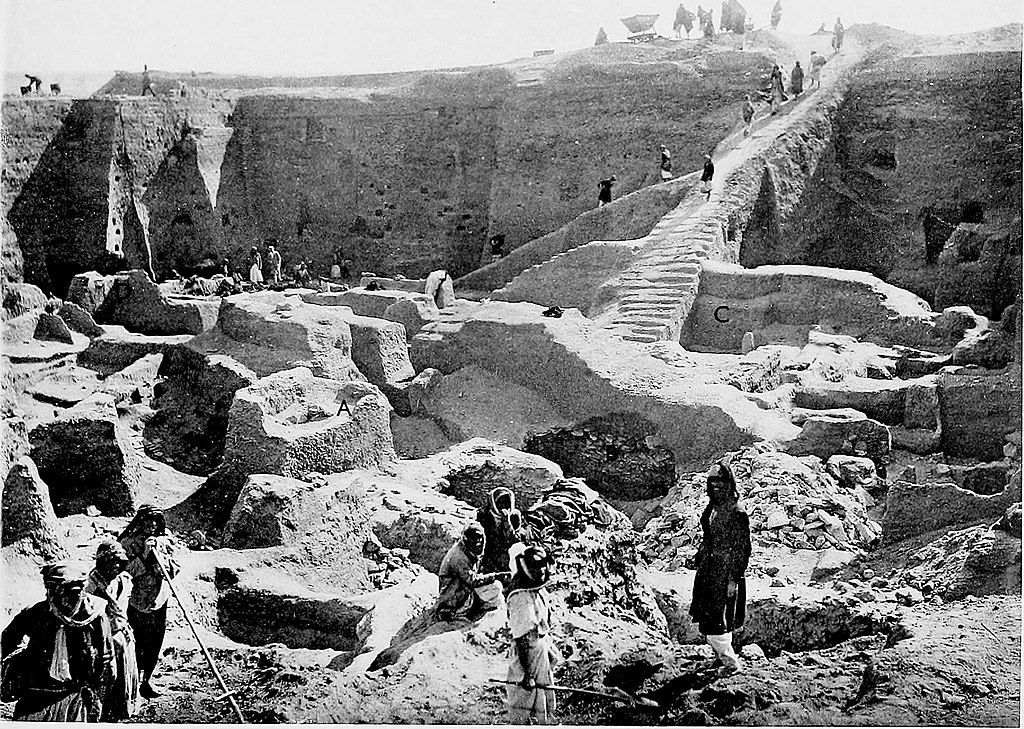
Excavating the Royal Cemetery of Ur, 1900. H.R.Hall, (1873-1930), ed. Sir Leonard Woolley (1880-1960) (PD0)
A mystery surrounds the Sumerian civilisation. As the writer Laurence Gardner29 points out, ‘To this day, everyone concerned is baffled by the sudden, extraordinary emergence of the Sumerians, seemingly from nowhere… There is no doubt that, upon their advent in southern Mesopotamia, they were already highly advanced, to a level far beyond that recorded or sustained in any place from where logically they could have emanated. Nowhere on Earth was there a culture like that of the Sumerians, who appeared soon after 4000 BC… a civilisation which progressed the legacy of humankind thousands of years ahead of natural evolution.’30 It was the Sumerians who invented the wheel, the chariot, the sailing boat, who traded and travelled, who designed kilns for baking bricks and pottery, worked as metallurgists and made implements such as the plough. They developed the first language to write down everything from laws to the story of the first super-hero, Gilgamesh. They used cylinder seals for signing contracts, and had a government that combined a ruler, local councils and elected officials. They brewed beer and invented the game of checkers. We still use their system of maths based on 60: the 60-second minute, 60-minute hour and 360-degree circle.

Level 7, Temple of Eridu as it might have looked in the Ubaid period
‘Eridu temple’ by Zunkir (CCBYSA3.0)

Great Ziggurat of Ur, side view
‘Zig close’ by Kaufingdude (CCBYSA3.0)
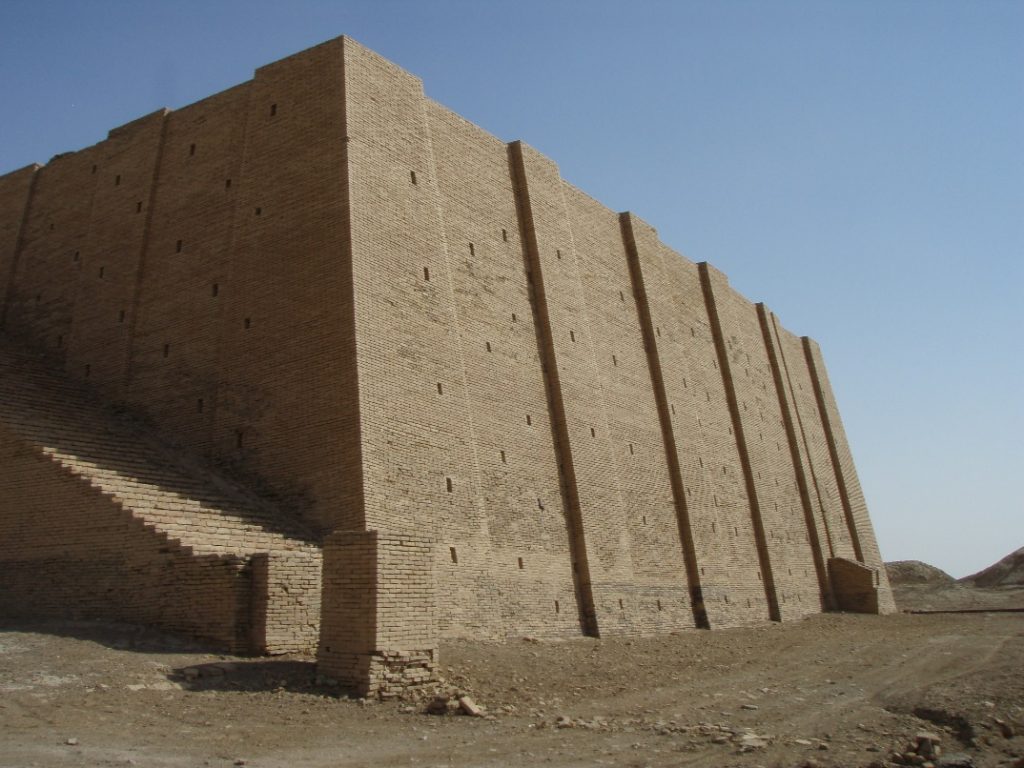
Great Ziggurat of Ur
‘Zig from side’ by Kaufingdude (CCBYSA3.0)
The ancient script found on the half-million or so clay tablets dug up in Mesopotamia is recognised to be the oldest sophisticated form of writing in existence. Nevertheless, says Gardner, ‘there is no region on Earth which identifies any scribal concept that might have been its forerunner. It appeared in a complete and composite form, as if from another world, in the style known as cuneiform (wedge-shaped).’31 It was used for over 3,000 years to write 15 different languages including Sumerian, Akkadian, Babylonian, Assyrian, Elamite, Hittite, Urartian and Old Persian. In 1872 George Smith’s breakthrough translation of the Flood myth The Epic of Gilgamesh from cuneiform clay tablets started to shift the spotlight of ancient history away from the Bible which had dominated belief systems for centuries. Nevertheless, a heavy religious bias continued in the world of Sumerian scholarship.32
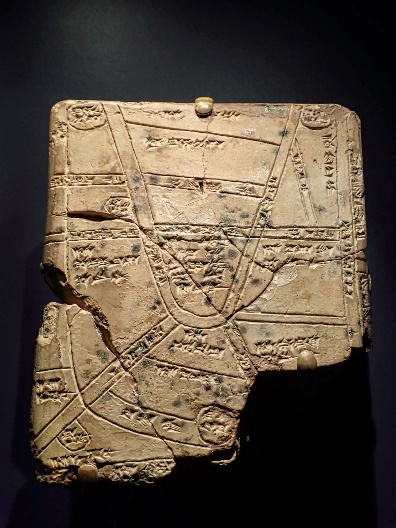
‘Babylonian cuneiform tablet with a map from Nippur 1550-1450 BCE’ by Mary Harrsch (CCBY2.0)
There has also been a tendency to overlook the obvious. Scrutinising the statues, carvings and cylinder seals of ancient Mesopotamia, it is plain to see that the cultural landscape was peopled with many extremely weird creatures. For every bearded Sumerian man and dumpy Sumerian woman portrayed, there are fishmen, bullmen, nursing mothers with reptilian heads, gods with lamp-like eyes, men sitting in winged contraptions up in the sky, the mušḫuššu/sirrush (a small curly-snouted dragon), griffins, tall hawk-headed winged creatures with handbags and cones, shaggy-legged fauns, long-necked sauropods, scorpion-legged beings – the list goes on. Scholars politely overlook this hybrid menagerie teeming before their eyes when it is clear that here was a civilisation like nowhere else.
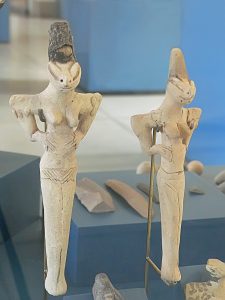
Figurines of women with reptilian heads
‘Two female figurines with bitumen headdresses ceramic Ur Iraq Ubaid 4500-4000 BCE’ by Mary Harrsch (CCBY2.0)
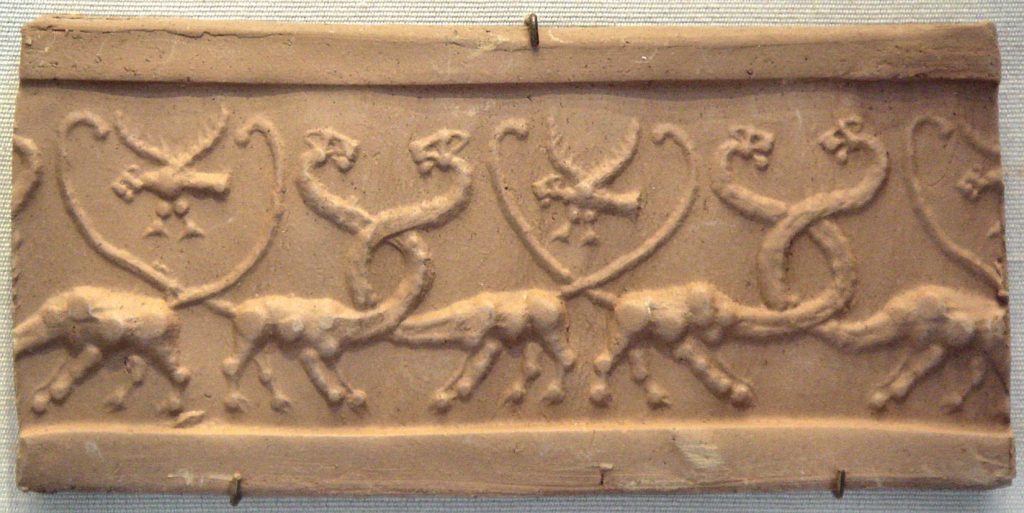
Modern clay impression of a cylinder seal with lion-headed sauropod hybrids and eagles, Mesopotamia, Uruk Period (4100–3000 BC). Jastrow (2006),
‘Uruk3000BCE’ by PHGCOM (CCBYSA4.0)
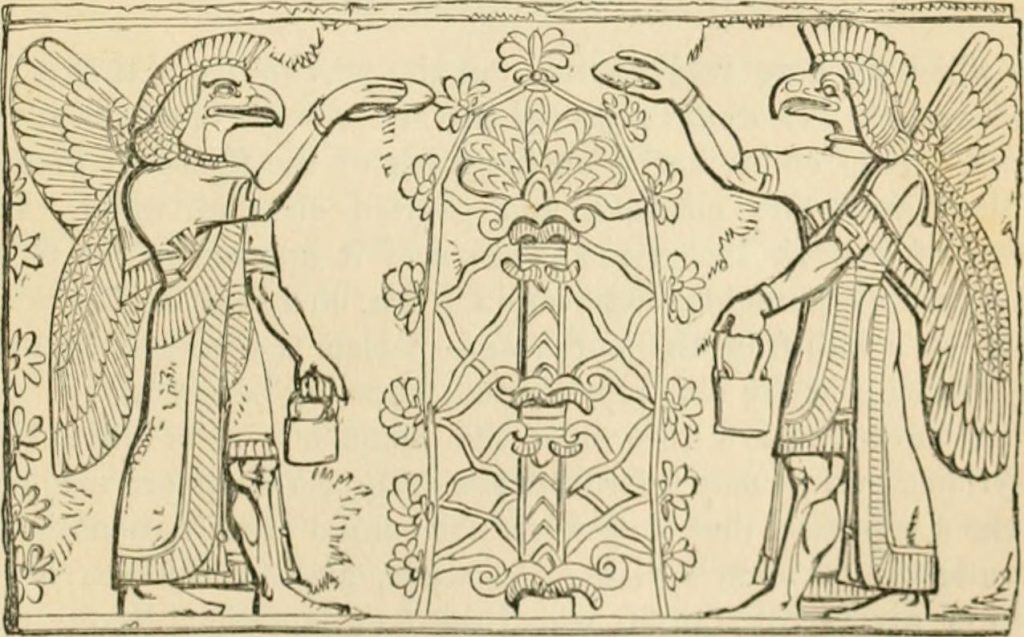
Plate from Nineveh and Persepolis: a historical sketch of ancient Assyria and Persia, with an account of the recent researches in those countries,
W,S,W, Vaux (London, A.Hall, Virtue & Co., 1850) (PD0)

Statue of the god Marduk with pet mušḫuššu, depicted on a cylinder seal of the Babylonian king Marduk-zakir-shumi, 9th century BC (PD0)
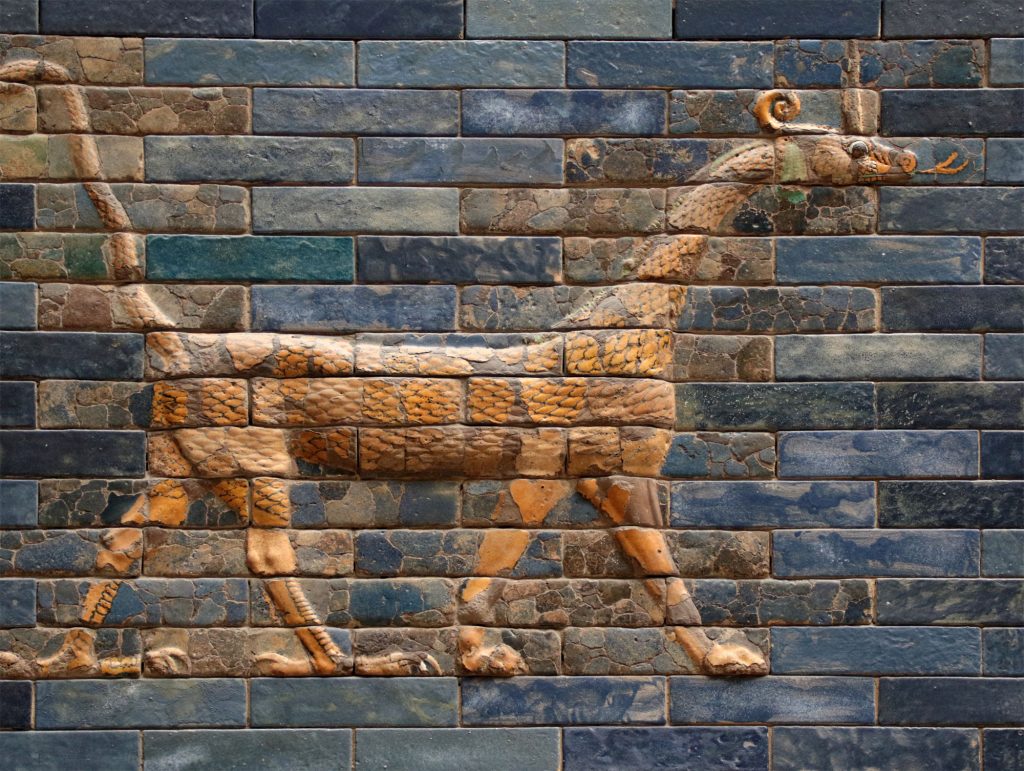
The dragon-like mušḫuššu/sirrush, with the hind legs of an eagle, lion-like forelimbs, a long neck and tail, a horned head, snake-like tongue, and a crest. From the wall of the reconstructed Ishtar Gate, Babylon, 6th century BC
Mushkhusshu, il drago-serpente’ by Raffaele pagani (CCBYSA4.0)
What does the Kolbrin say about Sumer? The Kolbrin is a patchwork remnant of a much larger collection of books most of which are long lost, including much historical material33. But the Books of Creation and Gleanings include historically-linked events set in a place called ‘Shinara’ (Shinar is the Hebrew name for Sumer) and are dotted with Sumerian names.
The Book of Creation says that some of the Children of God ‘came out of the barren places and learned the ways of builders… raising cities along the rivers. Among them was Enkilgal who built Keridor, which stands between the two great rivers, and Netar and Baletsheramam who taught men the ways of writing, setting the letters upon a pillar in Herak34 ‘Keridor’ is probably a skewed version of Eridu, ‘Enkilgal’ a skewed version of Enki, and ‘Herak’ a skewed version of Uruk. The book of Gleanings says that after the Worldwide Flood, Hanok/Noah’s ‘brothers divided the water-washed land between them. One… ruled the western waters. One ruled the eastern waters… The other raised up Eraka in the midst of them, and he was the greatest. The city of Eraka stood for a thousand years…’35 ‘Eraka’ is surely the city of Erek/Uruk, thought to have been the world’s largest city in its time. Elsewhere, ‘Nintursu’, described as ‘last of the line of Sisuda’, ‘Maiden of the Temple’ and mother of Gilgamesh, is a skewed version of Ninsun, a Sumerian goddess. ‘Nimrod of the Twin Bows’ can be identified with the Nimrod of Genesis36, a mighty hunter who ruled in Shinar. ‘Sisuda’ of ‘Sharapek, now called Sarapesh’ is Ziusudra of Shuruppak, the last king to rule from Uruch/Erech before the Worldwide Flood.
But the Kolbrin contains rather more than skewed Sumerian names: within its pages is a story linked to some of Sumer’s most enigmatic writings.
Reading myth as history
Three authors stand out from others for their revolutionary thinking on Sumer: Zecharia Sitchin, the husband and wife team Christian and Joy O’Brien, and Laurence Gardner. All three are branded ‘pseudohistorians’ by mainstream Sumerian scholars. All three did what journalist Charles McLaren and archaeologist Heinrich Schliemann did before them37: they read ancient epics, not as myths, but as records of actual events.38 A significant trend emerges here. Some of the huge discarded corpus of so-called ‘mythology’ is being dusted off and reconsidered in the light of archaeological and scientific discoveries. J.R.R. Tolkien’s immortal line, ‘History became legend. Legend became myth’39, sums up the inevitable, desiccating effects of time and human attitudes over remembered events and, as it turns out, is especially true of ancient Sumer, forgotten for so long.
Zecharia Sitchin
The 1968 publication of Chariots of the Gods by the Swiss author Erich von Däniken first popularised the theory that advanced extra-terrestrial beings had visited the Earth and made contact with our ancestors in prehistoric times. It was followed eight years later by the ground-breaking book The 12th Planet, written by Zecharia Sitchin (1920-2010), an Azerbaijani-American Orientalist and biblical scholar40 who based his findings on his own interpretations of Sumerian/Akkadian cuneiform tablets, archaeology and ancient texts. He offered a radical answer to the question of human origin. ‘Man’, said Sitchin, ‘is the product of evolution; but modern Man, Homo sapiens, is the product of the “gods”. For, some time circa 300,000 years ago, the Nefilim took ape-man (Homo erectus) and implanted on him their own image and likeness… Finally, the perfect Man was achieved – the one Enki41 named Adapa; the Bible, Adam; our scholars, Homo sapiens.’
Who were these ‘gods’? Sitchin believed they were the people referred to in the Book of Genesis42 as ‘Nephilim’, Hebrew for ‘those who were cast down upon Earth’, who he was convinced came from another planet. Elsewhere he interpreted a Sumerian term for Nephilim – ‘people of the shem’ – as ’people of the fiery rockets’. He identified the Nephilim with a group known in Sumerian, Akkadian, Assyrian and Babylonion traditions as the ‘Anunnaki’, also known as the ‘’Grand Assembly’ or ‘Assembly of the Gods’, who were said to have shaped the destiny of the Sumerians. Sitchin’s readings of cuneiform led him to believe that during an early celestial collision, the twelfth planet of the Solar System, Nibiru, home to the Nephilim, had seeded planet Earth with life; as a result, the humanoid Earth species selected to be artificially engineered by the Nephilim into servant beings was genetically akin to the Nephilim themselves. He expanded these theories and many more in his seven-volume Earth Chronicles. Sitchin’s work has been much criticized for over-speculative claims, overreaching interpretations and imprecise sourcing and dating; nevertheless, his ideas have attracted a vast following.
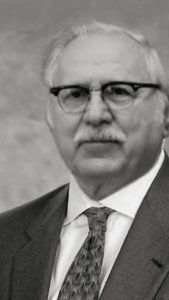
Zecharia Sitchin (PD0)
Christian and Joy O’Brien
In 1985, a British husband and wife team, Christian O’Brien (1914-2001) and Joy O’Brien (1921-2017)43, published The Genius of the Few: the story of those who founded the Garden in Eden44, later expanded into The Shining Ones45 (2001). An exploration geologist, Christian O’Brien was one-time head of the Iranian oil industry who was involved in the discovery of the Tchoga Zambil ziggurat in Iran. Developing a keen interest in ancient Mesopotamian civilisations, he noticed a heavy religious slant in the translations he was reading. He came to believe that early Sumerian texts had often been copied by later Babylonian scribes whom he described as ‘inveterate deifiers of archaic personalities’; that because of the ‘ritualistic nature of their developing religious susceptibilities’ they gave their texts a religious veneer; and that thousands of years later, late-19th-century/early 20th-century translators with their own Judeo-Christian bias often failed to realise the historical value of what lay underneath this veneer. (The ubiquitous phrase ‘ritual significance’ comes to mind here.)
O’Brien taught himself Sumerian/Babylonian cuneiform and Hebrew, then went searching for proven alternative meanings which he scrupulously researched and believed more closely fitted the Sumerian texts and the Book of Genesis creation story. For example, the much-disputed term ‘Elohim’ in the Book of Genesis became ‘The Shining Ones’ or ‘Anannage’ (Sitchin’s Anunnaki); ‘gods’ became ‘lords’; ’heavens’ became ‘the planted highlands’; the original meaning of ‘serpent’ was reinstated to mean ‘a wise man or woman’ and not a snake46, and so on. O’Brien was clear that the Anunnaki had ‘descended’, but did not dwell on where they were from.

Christian O’Brien
‘C.A.E. O’Brien’ by Jstars780 (CCBYSA4.0)
Looking at the standard translation of the Sumerian epic Atrahasis47, the O’Briens saw that its publication in 1999 predated widespread awareness of in vitro fertilisation, a procedure described in the Sumerian text48 and it occurred to them that the translators might not have known the precise nature of what they were translating. The O’Briens thought that the original Akkadian translators might not have known what they were translating either, since in vitro fertilisation had been carried out before their time by a long-gone advanced people. So Christian O’Brien made his own translation in the light of modern scientific knowledge, replacing phrases such as ‘shed blood/slaughtered’ with ‘gave blood’; ‘spittle’ with ‘semen’; ‘clay’ with (more speculatively) ‘piece of life/material of life/female ovum;’ and ‘birth-goddesses’ with ‘foster-mothers’. O’Brien also suggested that ‘Creatress of Mankind’49, a title given to the birth-goddess in Atrahasis even before she performed the in vitro fertilisation described in Atrahasis, indicates that she might have artificially engineered mankind at an earlier time.
Comparing the O’Briens’ interpretation of the Sumerian texts with Sitchin’s, the writer Edmund Marriage is in little doubt which is the more plausible. He points out that the O’Brien interpretation contains ‘…no Sumerians before 3,378 BC, no slave species, no Niburu, no nuclear wars between the Gods, no 1950’s space technology, space helmets, splash-downs, and no gold used for repairing damaged atmospheres. The Abzu [a word meaning ‘primeval deep source’ which Sitchin said was where precious metals were mined] was in Southern Lebanon not South Africa. Agriculture was re-started at Kharsag in the Southern Bekka and Jordan Valley around 9,400 BC following the Great Younger Dryas Ice Age by… the culture-bearers, who took the technology and seeds around the world in the next 2,000 years… Farming was… delivered into Mesopotamia by the apkalu… under the Enki… the Lord of the Land, and the Enlil… Lord of the Cultivation or Plough, and… Lord of the Spirits. The great cities were dedicated out of respect to the original Anannage leaders and their families, led by An, the monotheistic God of Abraham.’50
Laurence Gardner
Laurence Gardner (1943-2010)51 was a British constitutional historian and lecturer best known for his explorations of Atenism and Judaism, the Knights Templar, the Holy Grail and Freemasonry. His 1999 book Genesis of the Grail Kings52 explored, among other things, the Anunnaki/Grand Assembly/Assembly of the Gods and the artificial engineering of human beings. Gardner was convinced that the Anunnaki had been living beings. He wrote:
‘Every item of written and pictorial attestation confirms that the ancient Sumerians were absolutely sincere about the existence of the Anunnaki… They were patrons and founders; they were teachers and justices; they were technologists and kingmakers… but they were certainly not idols of religious worship as the ritualistic gods of subsequent cultures became. In fact, the word which was eventually translated to become “worship” was avod, which meant quite simply “work”. The Anunnaki presence may baffle historians, their language may confuse linguists and their advanced techniques may bewilder scientists, but to dismiss them is foolish. The Sumerians have themselves told us precisely who the Anunnaki were, and neither history nor science can prove otherwise…53
He added: ‘The eight kings in the pre-Flood list are said to have reigned for a total of sixty-seven shas, a sha being denoted by a circle ◯ = 360° The word comes from sha-at-am, which literally means ‘a passing’, and a 360° passing can be related to the completion of an orbit…. If the Anunnaki had their own orbit and, as the records suggest, their own equivalent of an annual calculation (the 360° sha ◯), then, try as we might to find another explanation for their existence, everything points to their being from another world. In this regard, the King List is quite specific, stating that their office of kingship was “lowered from heaven”.’54
In his later writing The Origin of God55, Gardner gives a nod to Sitchin’s controversial theory of the Anunnaki being from another planet, but he also proposes that they might have been ‘the surviving descendants of an advanced earthly race which had persisted from very early times’.

‘Laurence Gardner’ by Freiher (CCBYSA4.0)
The Anunnaki and the Epic of Atrahasis
Central to the thinking of these three authors is Atrahasis, a Sumerian/Akkadian epic containing a creation narrative and a flood story.56 The creation section describes how the Anunnaki take the blood and semen of their own species, mix it with ‘that which is life’ (usually translated as ‘clay’ but thought by Sitchin/the O’Briens/Gardner to have been the ovum of primitive female hominids) in seven male and seven female versions, then implant it into the wombs of fourteen hominid foster-mothers to carry to term and create a lullû or ‘one that is mixed’. This remarkable experiment is done in response to a protest by their own workers who are finding the hard labour on Earth too much and want to be replaced.
What has the Kolbrin to do with the Anunnaki? Below are two Kolbrin references to the Children of God:
‘Time passed, and the Children of God were grown strong and upright. There was one among them who… knew all things… hidden from the eyes of other men… because he walked with God he was culled out from his kind and brought to… the Gardenplace… In his sleep he… saw before him a being of indescribable glory… who said, “I am the God above all, even above the God of your people… You… are now made my governor on Earth…This will be your labour and, behold, here is your reward.”…The… man saw another form emerging. It was that of a woman, but one such as Fanvar57 had never seen before… a wraith, an ethereal being. [Later] the Spiritbeing became clothed with flesh… and… rose a mortal woman… God enlightened Fanvar… saying, “This woman was drawn from her compatible abode… Her coming accomplishes something which would otherwise have taken countless generations.”’58
‘A race of men came out of the cold northlands. They were under a wise father and above them was the Grand Company which later withdrew in disgust. This race was the Children of God; they knew Truth and lived in the midst of peace and plenty.’59
So the Children of God were controlled by a higher power. Who culled Fanvar out from his kind and brought him to the Gardenplace? Who gave him a selected female mate? Who sent the Children of God out of the cold northlands? The answer is ‘the Grand Company’ – surely none other than the Grand Assembly, Assembly of the Gods or Anunnaki.
If the Children of God were controlled by the Grand Company (plural), then why are they called ‘Children of God’ (singular)? Readers will assume this God to be the conventional Judeo-Christian God of the Book of Genesis. But the Old Testament, aside from being a historical record, was ‘specifically designed to underpin a monotheistic faith’60 and it has been suggested that Old Testament historians might have replaced the names of multiple gods with the single controller ‘God’, ‘Yahweh’ or ’Jehovah’ in order to promote their beliefs.61 Bearing in mind that the Egyptian Books, during their long history, are said to have been brought to Britain and kept at Glastonbury Abbey,62 it is possible that Christian scribes might have done a similar edit and changed ‘Children of the Gods’ to ‘Children of God’ throughout.
The earlier Kolbrin mention of ‘the laws of fate and destiny’ circumscribing human evolution may be relevant here. The Enuma Elis/Babylonian Epic of Creation describes how seven gods (Anunnaki) use an artefact called ‘the Tablet of Destinies’ when planning the future of the Sumerian people. This is the earliest use of the term ‘destiny’, meaning divine power by which events are unalterably predetermined. So, when the Kolbrin says that ‘unlike the beasts and birds their yearnings are circumscribed by the laws of fate and destiny’, it indicates that people differ from other evolved creatures in that their development has additionally been manipulated by a superior power.
Adam Adapa
Could there be a connection between the Anunnaki’s human engineering story in Atrahasis and what happens in the Book of Genesis? There is indeed a link and, intriguingly, it is the Kolbrin which pulls Sumer and the Bible together.
The link lies in two names: Sumerian ‘Adapa’ and Hebrew ‘Adama’. The Sumerian Adapa legend was discovered on tablets in the Nineveh library ruins of King Ashur-banipal of Assyria, and also in the Egyptian archives of Pharaoh Amenhotep III c. 1400 BC; the legend tells of Adapa, ‘a semidivine being, the provisioner of Ea’s temple in the city of Eridu. Ea had created, or begotten, him to be a leader among men; he had granted him divine wisdom, but he had not granted him the gift of eternal life.’63 Ever since these tablets were discovered, scholars have suspected that the Adapa character bears a resemblance to the biblical Adam. Laurence Gardner even writes that ‘Adapa the Adâma was truly a “mighty man” (hu-mannan), who was given extraordinary powers of control, being anointed … into kingship…”’64 65
Turning to Genesis, what does the Hebrew name ‘Adam’ mean? The Anchor Bible commentary says, ‘In ‘ādām “man” and ‘ªdāmā “soil, ground” there is an obvious play on words… The closest approach in English to the juxtaposition of the Hebrew nouns… might be “earthling: earth”.’66 So Adam Adapa means ‘Adapa the Earthling’.
The Kolbrin’s Gardenplace67 narrative (a version of the Garden of Eden story68), begins with ‘a being of indescribable glory’ saying to Fanvar… ‘You… are now made my governor on Earth’, which echoes the idea of Adapa as a leader anointed into kingship. The story ends with a spiritbeing reprimanding the man and woman: ‘Woe to you and your house, for the greatest of evils has befallen the race of the Children of God and it is defiled. The heritage of Kadamhapa is lost.’69
What is this strange word ‘Kadamhapa’? It looks to be yet another of the Kolbrin’s skewed names. Take it apart – ‘K-adam-hapa’ – and it becomes a garbled version of ‘Adam Adapa’. So what does losing ‘the heritage of Adam Adapa’ mean? There are a few clues. Firstly, we know from Genesis that Adam and his wife Eve were expelled from the Garden of Eden for eating from the Tree of Knowledge of Good and Evil70. Secondly, the Adapa Tablet says that the first man, Adapa, was endowed with wisdom but not with immortality. Thirdly, the word ‘heritage’ carries the now-obsolete meaning of ‘lineage’ – a condition transmitted to descendants from their ancestors. Put all these together, and ‘losing the heritage of Adam Adapa’ means losing immortality and leaving the Gardenplace/Eden because Adam Adapa’s descendants, the Children of God, have been defiled by ‘the greatest of evils’.
Defiled. The Kolbrin is speaking about something being tainted or spoiled. And it is clear from what follows that this is nothing less than dramatic and destructive genetic damage.
How does this apply to the Children of God? Tracing their lineage, they were descended from those who struggled harder, whose forefathers had crossed the great dark void, whose desires were turned Godward instead of spending all their time eating, drinking and fornicating like the hominids around them. If the Children of God were descendants of Selok the ape and Heavenman, they would have been mentally more advanced and physically more upright than their fellow hominids. At some point, a few of their females .would have been used for artificial insemination by the Anunnaki. Later on, the most advanced among them, Fanvar, was spotted by the Grand Company, culled out and brought to work in the Gardenplace. There he was granted governorship of the Earth, given a mate, Aruah, and joined by other Children of God71.
The female from another realm
Aruah72, the woman selected to be Fanvar’s sexual partner, is a most unusual being. The Kolbrin says she first appears as ‘a wraith’ in the form of a woman, ‘but one such as Fanvar had never seen before’. Bear in mind that Fanvar’s species has already been in existence for a long time, so he is used to women of his own kind. One day, says the Kolbrin, when Fanvar lies wounded after fighting off Yoslings (‘not true men but kinsfolk to the beasts of the forest’) the wraith ‘came and lay beside him, taking blood from his wound upon herself so it congealed about her. Thus the Spiritbeing became clothed with flesh, born of congealing blood, and being sundered from his side she rose a mortal woman.’73
This impossible text needs another Christian O’Brien to analyse the original wording in modern scientific terms. Fanvar is told that the woman has come ‘from her compatible abode in a realm of beauty… Her coming accomplishes something which would otherwise have taken countless generations.’ This indicates that she has not evolved, so perhaps she has been created and/or moved from another ‘realm’ to Earth. She might have been Anunnaki – we just don’t know. Fanvar is told that: ‘This woman is not as other women, being in no way like yourself; every hair of her head is unlike that of a man, every drop of blood and every particle of flesh is that of a woman and quite unlike that of a man. Her thoughts and desires are different; she is neither coarse nor uncouth, being altogether of another, more refined realm…’74 Engineered with Fanvar’s ‘blood’ (which probably means his DNA), Aruah would have become part-Child of God.
As if to confirm her origins, the Kolbrin goes on: ‘Aruah brought but one thing with her when she crossed the misty frontier, the treasure of Lanevid, the jewel contained in the moonchalice… She followed the ways of the cradleland, not the ways of Earth.’ So Aruah is definitely not from Earth. The text also says that she ‘had twinsight, an ability to see wraiths and sithfolk75, ansis76 and spiritbeings, all the things of the Otherworld, not clearly but as through a veil’.77
This begs the question: what did Fanvar and Aruah look like? The Anunnaki’s servants – those artifically created to serve them – are portrayed as smooth and hairless and, unlike their masters and mistresses, they are shown working naked.
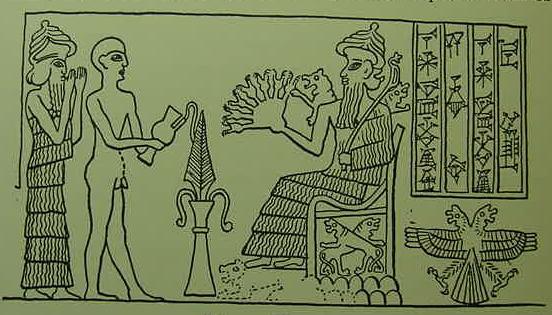
Ningirsu – Cylinder seal impression, illustrations from The Mythology of All the Races, Semitic [Vol. 5],
Stephen Herbert Langdon (Archaeological Institute of America, 1931) (PD0)
An astonishing pedigree
The Kolbrin lists the descendants of Child of God Fanvar and his sexual partner Aruah, detailing their offspring who mated with other Children of God:
‘Aruah brought forth a son by Fanvar and he was called Rautoki, and a daughter who was called Armena. Each knew the mysteries of magic and the ways of the stars. In the fullness of time Rautoki married among the daughters of the Sons of God and had two sons, Enanari and Nenduka. It was Enanari who first taught the weaving of cloth from plants, and Nenduka was a mighty hunter. Armena also married among the Sons of God and brought forth a son who was called Belenki and daughters called Ananua and Mameta. Ananua knew the making of pots and things of clay and Mameta the taming of beasts and birds.78… Nenduka had two sons, Namtara and Kainan. Namtara had two sons also, Nenduka and Dadam, before dying in the fulness of manhood. Belenki married Enidva and had a son called Enkidua and a daughter called Estartha, meaning Maid of the Morning, and she became a great teacher among The Children of God. This was the Estartha who became the first Moonmaiden, being later called Lady of The Morning Star. Enkidua had a daughter and her name was Maeva… Dadam, the Firstfather, married Leitha and they had a son called Herthew. Dadam then married Maeva.’79
Unpicking the skewed names in bold, ‘D-adam the Firstfather’ must be Adam, and ‘Ma-eva’ is Eve. They were the great-great-grandchildren of Fanvar and Aruah.
By now, the Children of God shared a rich pedigree with differing proportions of
(1) Ape DNA
(2) Heavenman DNA
(3) Anunnaki DNA resulting from one or possibly two in vitro fertilisations
(4) Non-Earth DNA from Fanvar’s mate Aruah.
With every addition of non-Earth DNA they were becoming more advanced, and with more and more Anunnaki genes, their lifespans were lengthening.
The Elixir of Life
In case there is any doubt about the Children of God being artificially created, the Kolbrin states that Fanvar, Aruah and the Children of God living with them in the Gardenplace all take special nutritional supplements to keep them healthy:
‘Within the Gardenland was the Sacred Enclosure, the domain of Fanvar and Aruah, forbidden to those of The Children of God who had now come to this place. It contained the Chalice of Fulfilment… None might drink from this save Fanvar and Aruah. Also there was the Cauldron of Immortality containing an essence distilled from the fruits growing in the garden, and this guarded against mortal ills…80 Outside the Sacred Enclosure… was a shrine wherein was kept a sacred vessel called Gwinduiva [‘God’s wine]81. Above the cup appeared a shimmering moon-coloured mist… At certain times, when the Heavens were in a proper position, the Gwinduiva was filled with moondew and potions from the cauldron within the Sacred Enclosure, making a pale honey-coloured liquor, and this the people drank. However, there were different proportions in the vessel for those of the blood of Fanvar and Aruah and those who were Children of God but not of their blood. It was the potion from the Gwinduiva which kept sickness and disease away from those who drank it.’82
Here, surely, is the origin of that most mysterious memory in our collective unconscious83, the elixir of life – a liquid which cures every disease and gives eternal life and youth to the drinker. Moving for a moment to the Kolbrin’s Celtic Books, the Book of Britain mentions a moon-chalice which has come from Egypt: ‘The heart of Britain is the moon-chalice which was brought here by the Chief of the Kasini… It was kept secure with the Grailstone and the ever-virgin vessel which brought down the rays of the sun… these treasures of Egypt came to Britain. This was the secret of Britain.84’ The text also says that, ‘at the midsummer festival the Chief of All the Druthin [Druids] collapsed … died in the arms of Joseph our father [Joseph of Arimathea]. It was he who received the moon chalice and the light of Britain.85’ If it passed into the keeping of Joseph of Arimathea, then the Gwinduiva/moon-chalice from the Gardenplace and the legendary Grail might well have been one and the same.

he Holy Grail of Valencia – an agate cup believed to have been used by Jesus at the Last Supper
‘Holy Grail of Valencia’ by Jmjriz (CCBYSA4.0)
Genetic damage – the Fall of Man
Initially the Anunnaki bred human beings to do their heavy work, including agriculture and gardening86, but the Kolbrin makes clear that later on, the best human specimen was nurtured with nutritional supplements, bred with a non-Earth female, and the resulting species protected so that they and their descendants would experience disease-free and lengthy lifespans, perhaps nearing those of their Anunnaki creators. What happened to end this remarkable genetic programme? The Bible’s story of Eve, the serpent, the apple and sexual shame is too well known to repeat here. What is not known is the tragic story told in the Kolbrin’s Book of Creation87 – so similar in outline and yet so different in essentials from the Bible’s Garden of Eden story88. Here it is, slightly abridged, with square bracketed comments:
‘About the land of The Children of God was the wasteland where Yoslings… They Who Inherit Death, dwelt. Amongst these, Namtenigal, the wily hunter, was the most wise and cunning; he alone was unafraid of The Children of God and he alone dared enter the Gardenland.’
[Namtenigal the Yosling is called ‘the wily hunter… the most wise and cunning’ and in the next paragraph, ‘the wily one’. This might well have been the original use of the word ‘serpent’ which Biblical scribes took to mean ‘snake’]
‘… When Estartha [a great-grandchild of Fanvar] was teaching, Namtenigal often came to hear her words and the Children of God were not displeased, for teaching the wild men about them was a duty with which they had been charged.’ [A duty charged by whom? Presumably, by the Anunnaki].
‘Namtenigal, therefore, participated in their rites but could not partake of the elixir from the Gwinduiva, because this was forbidden. While it gave health and strength to the Children of God, safeguarding them from the sicknesses of the Yoslings, if given to others it caused a wasting away. It was also altogether forbidden for any of the Children of God to mate with the Yoslings, for this was deemed to be the most unforgivable of sins.’
[Forbidden to mate with Yoslings by whom? Presumably, by the Anunnaki.]
‘Now, the wily one learned much from Estartha and in the fulness of time brought his own son to her and he became as her son, living in her house and forsaking the ways of his people. Estartha called him Lewid the Lightbringer, for it was her intention that he should be taught the ways of those who walked in light, that he might in time enlighten his own people. Lewid grew up tall and handsome, he was quick to learn and became wise. He was also a man of the chase, strong and enduring, a hunter of renown. But there were times when the call of his people was strong, then he would go out furtively into the night to indulge in their dark rituals. Thus he became knowledgeable in the ways of the flesh and in the carnal indulgences of the body.
‘Beside the place called Gisar was a pleasant parkland with trees of every kind and a stream, also thickets of flowering bushes and all manner of plants growing lushly. It was the custom of Maeva [Fanvar’s great-great-granddaughter, wife to Dadam] to wander there… and Lewid also went there; so it came about that they met among the trees. Maeva … saw he was handsome, possessed of many attractions, so… she did not run away. As the days passed they dallied longer together and Lewid talked of things Maeva had not heard before. She felt a stirring in her blood but did not respond or heed his temptations, because of the things which were forbidden.
‘So Lewid went to the Moonmother, wise woman of the Yoslings, and… beseeched her to help him. The Moonmother gave him two apples containing a vile substance which they had drawn through their stalks; this Lewid gave to Maeva who then became helpless in his hands. They met again after this, for Maeva became enamoured towards Lewid, but it happened that she became ill with a strange sickness and was afraid. Then Dadam became ill and Lewid also, and Lewid said to the woman, “You must obtain the pure essences from within the Sacred Enclosure, and Setina, the Moonmother, will prepare an elixir which will cure us”. This he said because none of his kind had ever been able to obtain the Sacred Substances, though they had always coveted what had been denied them. Now, because of her frailty, the woman was pliable in his hands and Lewid seized the opportunity.’ [Apples are used in this version to convey a sedating drug.]
‘To achieve his ends Lewid gave Maeva a potion which had been prepared by the Moonmother and she administered this to Dadam and those with him, by guile and deceit, so that they fell asleep. While they slept Maeva stole from the Sacred Substances and took them to Lewid who gave them to the Moonmother, and she made a brew. Part of this was given to Maeva and the rest was drunk by the Yoslings, from their awful ankital during their night rites. When the morning came they were all smitten with grievous pains, and before the sun set that day all the Yoslings were stricken with a sickness such as they had not known before.’ [‘Ankital’ sounds like a container of some kind, maybe a cauldron.]
‘Maeva took what had been given to her and finding Dadam/ laid low in his bed gave him a draught from her vessel, though she had to use womanly wiles to get him to drink it. She drank the remainder and they both slept. But when they awoke in the morning both were suffering pains and this was something they had not known before. Dadam said to the woman, “What have you done, for what has happened to us cannot be unless the things which are forbidden have been done”. The woman replied, “…I was tempted…. I have done that which is forbidden and unforgivable”.
‘Dadam said, “… let us go into the Gisar… where I will seek enlightenment”. So they went there together and stood before the shrine beneath the Tree of Wisdom. There they were filled with an inflowing vision, seeing themselves as they were and as they should have been, and they were ashamed. He because he had not followed the proper path of a man and she because of her falsity. There, in the reflecting mist, the contamination of the woman was revealed, and the man’s heart shrivelled within him like a flower licked by flame.
‘Then they saw a great Spiritbeing materialising in the reflecting mist and he said to them, “Woe to you and your house, for the greatest of evils has befallen the race of the Children of God and it is defiled. The heritage of Kadamhapa is lost. The fetid flow defiling the woman89 results from the incompatible intermingling, but it is not all, for sicknesses and diseases are also generating from the ferments of the impure implantation”.
‘Dadam said, “The fault is with the woman, wherefore should I suffer?” The Spiritbeing replied, “Because you two are now as one the cankerworms of disease and sickness strike both equally, but you shall not again defile this place. Henceforth, the misty veil becomes an impenetrable barrier severing our two realms from each other, so they can no longer be easily spanned. Between us there will now be no means of communication. Henceforth, man and woman, fated [destined] to unite in love divine, shall be divided and set apart, though ever yearning reunion. They may cleave one to the other, seeking the unity which will rekindle the flame, but unless their efforts transcend the limitations of earthly things they will be in vain. The spirit of man is now severed from the whole and cast again into unconsciousness… The web of fate is rewoven and the paths of destiny remade, the design of life is redrawn; again the progression begins in ignorance, birth and death, pain and pleasure, joy and sorrow, success and failure, love and hate, peace and war…. This is a new beginning but a beginning not in purity… but one already weighted with debts and burdens… the decrees forbidding certain things were for your own benefit. Immortality was nearly within your reach, but had you achieved this you would have brought an even more grievous evil upon yourselves and your inheritors, for freed from servitude to change, you and they would have been unable to progress”.
‘The Children of God were driven out of the gardenland by Spiritbeings, and then guardians were set at its gates so none could re-enter. Then it was withdrawn beyond the misty veil, the waters ceased to flow and the fertility departed, only a wilderness remained. The Children of God went to dwell in the land of Amanigel, which is beyond the mountains of Mashur by the sea of Dalemuna.’90
Why was Ma-eva tempted?
This narrative raises many difficult questions. What made Ma-eva want to stray in the first place? The Kolbrin says she was attracted to Lewin the Yosling because he was ‘tall and handsome… quick to learn… wise… a hunter of renown… [and also] knowledgeable… in the carnal indulgences of the body.’ Eventually, Lewin used a drug to have his way with her, but it appears that was not the whole story. Was curiosity a factor? Could the fact that Children of God males had desires that ‘were turned Godward’ indicate that they had lower libidos than their womenfolk? Sumerian literature is clear that the Anunnaki were a highly-sexed species, and Ma-eva had Anunnaki DNA in her, in addition to which her great-great-grandmother, Aruah had not evolved on Earth and might have been highly-sexed, passing on the characteristic to her descendants.
What was lost by interbreeding with hominids
When the Children of God interbred with more primitive species, adulterating their carefully-engineered DNA, it was without a doubt the worst trauma in human history. The loss must have been almost inconceivable:
- Men’s and women’s DNA was now inextricably mixed with that of short-living hominids and their lifespans were doomed to dwindle.
- They would now be vulnerable to the many diseases endemic on Earth.
- Genetically, the Children of God’s descendants would be thrown back into a more primitive state. They would have to retrace the developmental path they had originally leap-frogged by being artificially engineered, but this time round they would receive no help from the Anunnaki, whose plan they had thwarted. Instead, theirs would be the lengthy evolutionary path, weighted down with problems, encountering for the first time human-style birth and death, pain and pleasure, joy and sorrow, success and failure, love and hate, peace and war.
- Human beings could no longer communicate with another dimension. The spirit of man was cut off from the cosmic whole and cast into ‘unconsciousness’.
- Men and women would never again achieve unity with their mates unless their efforts transcended physical sex.
The spiritbeing’s words indicate that up to now, the artificially-engineered Children of God had lived a protected, contented and balanced life. This was their Golden Age.
The Children of God were not the only ones to suffer. The Yoslings had drunk a substance designed to nurture the Children of God; if given to non-Children of God, it caused ‘a wasting away.’ Whether this was an affliction that continued down the generations, we are not told.
A shorter lifespan
‘Immortality was nearly within your reach’ says the spiritbeing when he reprimands D-adam and Ma-eva in the Gardenplace. This was probably not immortality in the sense of never dying. Gardner points out: ‘The Anunnaki were not immortal. There are no records so far discovered which related to their natural deaths, but numerous accounts refer to their individual deaths by means of war and violence.’91 So why were the part-Anunnaki Children of God described as having been on their way to becoming ‘immortal’? The answer must be that the long-lived Anunnaki were perceived as immortal by the shorter-living Children of God.
From ancient records, we know that before the Worldwide Flood, Mesopotamian rulers and the patriarchs referred to in the Book of Genesis lived extremely lengthy lives. The kings recorded on the Sumerian King List were noted for their remarkably long reigns. ‘After the kingship descended from heaven, Alumim’s reign in Eridug lasted 28800 years. Alaljar ruled for 36000 years… After the flood had swept over, and the kingship had descended from heaven… Jucur’s reign in Kic lasted 1200 years. Kullassina-bel ruled for 960 years, Nanjiclicma ruled for 670 years.’92 The Genesis patriarchs had lifespans which ran into many hundreds of years: Adam 930, Seth 912, Enosh 905, Cainan 910, Mahalalel 895, Jared 962, Enoch 365, Methuselah 060, Lamech 777, Noah 950. After the Worldwide Flood: Shem 600, Arphaxad 438, Shelah 433, Eber 464, Peleg 239… down to Abraham 175. Could it be that the Sumerian rulers all carried Anunnaki DNA, and that the Genesis patriarchs possessed some Anunnaki DNA which gave them long lives too?
Genesis 6:3 says: ‘And the Lord said, My spirit shall not always strive with man, for that he also is flesh: yet his days shall be an hundred and twenty years.’ This suggests that after the Garden of Eden/Gardenplace mismatings, the human lifespan dropped to 120 years.
The Kolbrin is unique in spelling out how the human lifespan shortened:
‘It came about that the sons of The Children of God mated with the daughters of The Children of Men… The covenant had been broken [the pact that the Children of God should mate only within their own species93]… This was when the years of man’s life were lessened because he became fully Earth-sustained, but he remained full of vigour…’94
‘Full of vigour’ suggests that humans might have been expected to weaken as their lives shortened, but this did not happen.
‘Ten thousand generations had passed since the beginning [the events of the Gardenplace]… The Children of God and The Children of Men had passed into dust and only men remained. One hundred generations had passed since the overwhelming deluge… Once man lived for less than two score years, now his years were three score and ten.’95
In the second snippet, the Kolbrin refers to a time when man only lived to be 40. Since the ‘overwhelming deluge’/the Worldwide Flood is mentioned in the previous sentence, post-Flood conditions might have been so appalling that humans lived brief lives. Another possibility is that after the second mismating between longer-lived, part-Anunnaki Children of God and short-lived hominids, the human lifespan dropped to 40 and then rose gradually over many generations during which the Children of God ‘mated out’ among the Children of Men, spreading their longer-living DNA and redressing the balance to the three-score-and-ten which was the length of a generation in the Old Testament.
The world’s first redhead
After her sexual mismating with Lewid the Yosling, Child of God Ma-eva conceived and gave birth to a daughter – ‘Gwineva the cuckoochild fathered by Abrimenid of Gwarthon, son of Namtenigal, whom we call Lewid the Darkfather’96 [the Serpent]. In old Welsh, gwyn=ache, pain or smart, gwynn=white, and the name Guinevere means ‘white ghost’.
Gwineva, says the Kolbrin, was the first person in the world to be born with red hair97. ‘Though all knew there were fair-haired and dark-haired people, none had ever seen anyone with red hair.’98 Even to this day, writes Jacky Colliss Harvey in her book Red: A History of the Redhead, the red hair gene MC1R is often seen on men as wild, and on women as ‘unrestrainedly sexual’,99 and where teasing is concerned, ‘gingers’ are usually considered fair game.
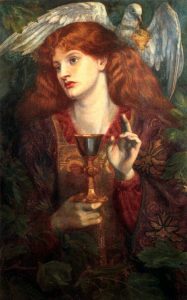
Red hair and the Elixir of Life combined in a single image: The Damsel of the Sanct Grael, Dante Gabriel Rossetti (1874) (PD0)

Rita Hayworth in The American Magazine, 1942 (PD0)
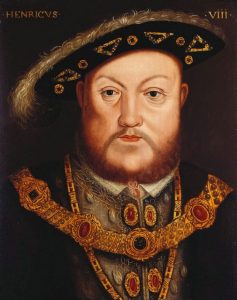
Portrait of King Henry VIII (PD0)

Rupert Grint of Harry Potter Fame
‘Rupert Grint 2012’ by Paul Bird (CCBY2.0)
The second mismating
‘Once all men were dark and hairy and in those days woman was tempted by the strength and wildness of the beast which dwelt in the forest101, and the race of man was defiled again102.
Later on and for a second time, states the Kolbrin, the Daughters of God had sex with more primitive hominids. ‘Therefore the Spirit of God was wrathful against woman…’ Is this an echo of the earlier text stating that the Grand Company withdrew in disgust? The Kolbrin continues, ‘Now, because of the wickedness that was done, there are among men those who are the Children of the Beast, and they are a different people. The race of man alone was punished, for the beast acted according to its nature. In man the beast and god strive to decide whether he shall take his place among the gods that live or the beasts that die, and woman, in her weakness, betrayed him to the beast.’103
Gradually a new species began to proliferate: the Children of Men. The Kolbrin gives us glimpses of them. ‘They were wild and savage; clothed in the skins of beasts they lived like beasts… woman was subject to man, and he imposed his will upon her and dominated her’104. Eventually ‘the daughters of the Children of God consorted with the sons of the Children of Men and were become unlike true women105.’ Among many other changes, it sounds as if the male appearance changed too. By the time of the second mismating, ‘all men were dark and hairy’ (this suggests that previously they had not been hirsute) ‘and in those days woman was tempted by the strength and wildness of the beast which dwelt in the forest’. This indicates that the Children of Men had degenerated genetically to a point where there was little difference between them and the beast which dwelt in the forest. Since that time, bodily hairiness has been associated with the savage, the primitive, the beast.
What was lost by the second mismating
How did the second ‘defilement’. affect mankind? Two incidents of mismating with two different species, a Yosling and a beast of the forest, would have introduced vast amounts of primitive genes into the Children of God’s advanced DNA. This double input would have increased their vulnerability to disease exponentially; up to then, according to the Kolbrin, the Children of God been drinking a substance from the moon-chalice which kept sickness at bay; in addition, Fanwar/Adam and Aruah/Eve and their direct descendants had been drinking special essences from the Cauldron of Immortality, which guarded against ‘mortal ills’. From now on these substances would be useless in protecting the Children of God’s altered DNA against disease, and their lifespan would be shortened even further.
The two mismatings changed women’s lives forever. The Children of God ‘valued woman highly and protected her from crudeness and cruelty’; but among the Children of Men who evolved from the mismating, woman was regarded as ‘a chattel… an object for the satisfaction of his lust and the servant to supply his needs…He subdued her and kept her in servitude, for her betrayal of man was known even among them [the Children of Men], and it was never forgotten, nor could it be forgiven’. It was woman and woman alone who was responsible for the double genetic damage to the Children of God by mating, first, with a Yosling, then with a beast of the forest. She did herself a great disservice, for while the Children of God regarded woman as man’s equal, the Children of Men punished her by using her as a sex-slave and dogsbody, which became the norm for many thousands of years.
As for the Anunnaki, they turned away disgusted and, presumably, disappointed as they watched increased hominid genes gradually transforming the Children of Men back into primitives ‘filled with hostility’, libidinous and misogynist, turning away from the agricultural skills they had learnt and worshipping warfare instead106.
But the Anunnaki’s Frankenstein creation had a couple of surprises in store: first, due to some mysterious genetic factor, some of the daughters born to the Children of Men grew up to be extraordinarily beautiful – possibly more beautiful even than Anunnaki women. We know this because both Genesis107 and the Kolbrin108 tell us that Anunnaki men started lusting after them, interbred with them, and the result was giants if you believe Genesis, monstrosities if you prefer the Kolbrin version; both Genesis and the Kolbrin agree that these liaisons eventually led to ‘wonderfully big and mighty fighting men and ‘mighty men which were of old, men of renown’. Secondly, despite increasing illness and shorter lives, the Children of Men did not wilt and die as expected: they proved to be strong and vigorous.
Homo sapiens
As scientists learn more and more about the human genome, we are all curious to know more about our species’ past. Yet, unbelievably, our early history seems to have been lost in the mists of time, and if we are to believe what the Kolbrin says about our beginnings, then we can only conclude that when the Book of Genesis came to be written, the scribes had so little idea what they were writing about that the extraordinary events ended up in garbled form which have never made much sense to anybody.
The Kolbrin account bubbles with elements which have reverberated down the ages and still float in our collective unconscious today, though we don’t know why. Generation after generation, why do so many women feel a nagging feeling of guilt that they can’t pin down? Why are some men born with an innate sense of misogyny, disliking women and not knowing why? Why, throughout history, have some groups felt they needed to keep their race ‘pure’? Why are red-headed or ginger-haired people often ostracised? Why is it that the bestselling paperback The Holy Blood and the Holy Grail109 and spin-off movie The Da Vinci Code, both with a sacred bloodline as their theme, have touched a universal chord with readers and movie-goers alike?
The events described in the Kolbrin forge an inextricable link between Sumer and the Book of Genesis. Could it be that, in its own inimitable way, the Kolbrin tells it like it was: that a species of great ape interbred by chance with aliens wandering the planet and became upright hominids? That the Grand Company came across these unusual beings and artificially engineered them, the first time as workers, the second time to be the Earth’s most advanced creatures? That their marvellous creations then blew it all by wilfully preferring sex with great apes? That, as a result, the Children of Gods/God found themselves deserted by the disgusted Grand Company and surrounded by increasing numbers of aggressive, hairy, women-hating Children of Men who, like it or not, were their offspring and descendants? And, after thousands of generations and endless intermingling, ‘the Children of God and the Children of Men… passed into dust, and only men remained’110?
What we do know is that those who remained were a short-lived, disease-prone species known as Homo sapiens – us.
The author welcomes correspondence with readers via [email protected]
Kolbrin text courtesy of The Culdian Trust.
References
3 https://www.nationalgeographic.com/science/2019/04/new-species-ancient-human-discovered-luzon-philippines-homo-luzonensis/
5 Humans are not from Earth, Ellis Silver (ideas4writers, 2017) offers a comprehensive evaluation of the environmental and ecological evidence for and against man’s evolution on Earth. Particularly intriguing is the fact that humans have only 23 pairs of chromosomes as opposed to the great apes which have 24. The second human chromosome is fused https://www.bbvaopenmind.com/en/science/bioscience/the-origin-of-the-human-species-a-chromosome-fusion/, something unique to human lineage in being the result of head-to-head fusion of two intermediate-sized ancestral chromosomes https://www.researchgate.net/figure/Pattern-of-recent-segmental-duplications-in-the-vestigial-centromere-region-on-chromosome_fig3_7920243.
7 Kolbrin, Creation 2
8 On the Origin of Species, Charles Robert Darwin, 1859
10 https://www.theguardian.com/science/2019/jul/10/piece-of-skull-found-in-greece-is-oldest-human-fossil-outside-africa
11 https://www.nature.com/news/oldest-homo-sapiens-fossil-claim-rewrites-our-species-history-1.22114
12 ‘How Humans and Apes Are Different, and Why It Matters’, Agustin Fuentes, Department of Anthropology, University of Notre Dame, Notre Dame, IN 46556, USA, Apr 03, 2018
13 Could this be a skewed version of ‘Eden’ or ‘Edin’? Usually skewed words in the Kolbrin have retained the original consonants, but in the case of an extremely ancient oral story the word might have become even more skewed than usual.
14The valley of Lod is in Israel to this day. It is mentioned first in 1 Chronicles 8:12: ‘The sons of Elpaal were Eber, Misham, and Shemed, who built Ono and Lod, with its towns.’
15 ‘The cavern of Woe’ probably refers to the genetic disasters following this mating.
16 Kolbrin, Creation 2:3-4
17 https://www.express.co.uk/news/science/634733/Do-demon-skulls-and-Nazi-briefcase-discoveries-prove-Third-Reich-contacted-ALIENS
18 Kolbrin, Manuscripts 31:5
19 Kolbrin, Creation 5: 1-2. The Sumerian Enuma Elish
20 The British Language in its Lustre, or a Copious Dictionary of Welsh and English, 1688 (Black Pig Press, facsimile 1977). Awen is an ancient Welsh Druidic term which for the past few centuries has meant ‘poetic gift’ or ‘inspiration’, but may once have had a different meaning, since it refers here to the evolutionary process. Awen is not the only Druidic term used in the Kolbrin. The word ‘enidvadew’ (skewed version of eneidfaddau) is found two paragraphs later in the Egyptian Book of Creation, and ‘Kewgant’ (skewed Ceugant as in ‘Circle of Ceugant’) and ‘Gwinvidon’ (skewed Gwynfud as in ‘Circle of Gwynfud’) both appear later in the Celtic Book of Britain. Eneidfaddau means ‘voluntary submission for punishment for a crime’ (see page.271, The King Arthur Conspiracy, Grant Berkley, Alan Wilson and Baram Blackett (Trafford, 2005). These terms beg several questions: were Druid beliefs much older that we think? Or were these ancient concepts adopted by the Druids when the Egyptian books arrived in Britain and fell under their scrutiny? Or did they edit the text in the Book of Creation at a later stage? Druids will form the subject of a future article.
21 Kolbrin, Creation 4:1-4
24‘Dominion of the sky-spaces’ is echoed in the Kolbrin’s Celtic Book of Origins, which speaks of ‘Gatumugna the Skyfighter, whose son… married Amerith, the Skychief’s daughter. Their sons were Nodinos the first earthling, and Magilmish the Wanderer, in whose days the sky chariots came. It is told how, in the glowering dawntime of the world, Amerith flew on swift wings of the spirit from her kingdom in the West to consult with Tuwait the Eastern Father, son of Gatumugna.’
25 Kolbrin, Creation 6:5
26 Kolbrin, Gleanings 2:2
27 Kolbrin, Creation 5:7
28 Quadrupedalism or habitually walking on all fours is now categorised as Üner Tan Syndrome (UTS). In recent years people discovered with this syndrome have included men and women mainly in Turkey and also in Morocco, Brazil, Iraq, Mexico and Chile. I have met someone with this condition. A friend in Turkey took me up to meet a pair of sisters living in a remote village in the Taurus mountains, who welcomed us into their traditional wooden house. What my friend had not prepared me for beforehand was the fact that one sister walked on all fours simply because she found it more comfortable that way. file:///C:/Users/defaultuser0/Documents/KOLBRIN/KOLBRIN/Walking%20on%20all%20fours/BBC%20NEWS%20_%20Science_Nature%20_%20Family%20may%20provide%20evolution%20clue.html
30Genesis of the Grail Kings, Laurence Gardner (Bantam Books, 1999)
31 Ibid.
32 In the 1890s, when a leading cuneiform specialist, the Rev. Professor George Barton of Bryn Mawr College, Pennsylvania started translating tablets from Nippur temple library, he had difficulty understanding more than 20% of the texts and fell into the trap – still seen today among many scholars – of putting religious or cult interpretations on key historical records where none originally existed. This over-religious perspective has clouded many subsequent translations.
33The entire contents of the Egyptian Books are listed in the Book of the Sons of Fire, Kolbrin, Sons of Fire 24
34 Kolbrin, Creation 6:9
35 Kolbrin, Gleanings 5:2
36 Genesis 10:9-10
37 An inspirational retelling of the rediscovery of Troy can be found in Gods, Graves and Scholars: the story of archaeology, C.W. Ceram, first published 1949 (Vintage Books, 1986).
38 It is unlilkely that any of these authors would have come across the low-profile Kolbrin, which was first published in 1994.
39 Spoken by Galadriel in The Fellowship of the Ring, The Lord of the Rings
41 a Sumerian god who instigated the engineering of humans – see K6634 (V), Obverse lines 204-215, Atrahasis: The Babylonian Story of the Flood, Wilfred G. Lambert and A. R. Millard (Oxford, 1969).
42 ‘Nefilim/Nephilim’ is a term used in the Hebrew Bible. The term is translated as ‘giants’ in the King James Bible and as ‘Fallen Angels’ elsewhere.
44 Dianthus Publishing. The Patrick Foundation, patrickfoundtinternet.com, www.goldenageproject.org.uk
45 Ibid.
46 Also reinstated by Sitchin
47 Atrahasis: The Babylonian Story of the Flood, Wilfred G. Lambert and A. R. Millard (Oxford, 1969).
48 Although the first IVF birth took place in 1978, it was not for several decades that the term ‘IVF’ came to be known and used universally. https://livio.se/en/research/history-ivf-brief/
49Atrahasis: The Babylonian Story of the Flood, Wilfred G. Lambert and A. R. Millard (Oxford, 1969), K6634 (V), Obverse, line 194.
52Genesis of the Grail Kings, Laurence Gardner (Bantam Books, 1999)
53Ibid.
54 Ibid.
55The Origin of God, Laurence Gardner (Dash House, 2010)
56Atrahasis: The Babylonian Story of the Flood, Wilfred G. Lambert and A. R. Millard (Oxford, 1969).
57Fanvar is the Kolbrin’s name for the Adam figure in the Gardenplace story. It might possibly derive from Arabic ‘Anwar/Anvar’ (‘Enver’ in Albania, Bosnia, Kosovo, and Turkey) meaning ‘luminous’.
58Kolbrin, Cretion 5:8-17
59 Kolbrin, Gleanings 1:9
60 The Origin of God, Laurence Gardner (Dash House, 2010)
61‘Elohim (Heb., God(s)). A name for the God of the Jews. Its plural form may once have been literal—‘mighty ones’—but it became subsumed in the accumulating Jewish sense that if God is indeed God, then there can only be what God is: One, and not a plurality of gods.’ The Concise Oxford Dictionary of World Religions, John Bowker
62 Introduction, Kolbrin
63 The Babylonian Genesis: the Story of Creation, Alexander Heidel, (The University of Chicago Press, 1951)
64Adapa Tablet, fragment 1
65Genesis of the Grail Kings, Laurence Gardner (Bantam Books, 1999)
66 The Anchor Bible, page 16, E.A. Speiser, (Doubleday & Co., 1964)
67 I have identified the Book of Creation’s ‘Gardenplace’ as the Garden of Eden in my article ‘Was This Eden? Locating The Kolbrin’s Gardenplace’, 29th July 2016.
68 Genesis 2:4-25, 3:1-21
69 Kolbrin Creation 5:34
70 Genesis 2:15-3:24
71 Kolbrin, Creation 5:7-17
72 Could this be a skewed version of the Hebrew name Hawah which we know as Eve? Hayah means ‘to live’.
73 Kolbrin, Creation 5:13
74 Kolbrin, Creation 5:15
75 Sith is a now-obsolete Old English word meaning ‘from the past’.
76 ‘Ansis’ might be related to Old English an-sín meaning ‘aspect, shape, form’. The word also appears in the Kolbrin’s Celtic books in the context of ghosts and Will’-o’the-Wisps.
77 Kolbrin, Creation 5:26
78 Kolbrin, Creation 5:18
79 Kolbrin, Creation 5:19
80 Kolbrin 5:17
81Gwin=wine, Dwyau=God in Old Welsh (modern Welsh Duw), so this translates as ‘God’s wine’.
82 Kolbrin, Creation 5:20
83 A concept originally defined by psychoanalyst Carl Jung. It refers to the idea that a segment of the deepest unconscious mind is genetically inherited and is not shaped by personal experience. According to Jung’s teachings, the collective unconscious is common to all human beings and is responsible for a number of deep-seated beliefs and instincts, such as spirituality, sexual behaviour, and life and death instincts. https://www.verywellmind.com/what-is-the-collective-unconscious-2671571#:~:text=The%20collective%20unconscious%20is%20a,not%20shaped%20by%20personal%20experience.
84 Kolbrin, Book of Britain 5: 36
85 Kolbrin, Book of Britain 4:26
86 Atrahasis BM 78257 (G), Column ii, lines 9-12
87 Kolbrin, Creation 5: 22-47
88 Genesis 2: 8-25m 3:1-24
89 A discharge following sex with a Yosling who genetically was only partially compatible with Daughter of God Maeva. This would not not have been a menstrual discharge (as I suggested in an earlier article on the Children of God) because at the time she was pregnant with a child fathered by the Yosling.
90 For suggested topography, see my article ‘Was This Eden? Locating The Kolbrin’s Gardenplace’, 29th July 2016
91 Genesis of the Grail Kings, Laurence Gardner (Bantam Books, 1999)
93 ‘It was also altogether forbidden for any of The Children of God to mate with the Yoslings, for this was deemed to be the most unforgivable of sins’. Kolbrin, Creation 5:23
94 Kolbrin, Gleanings 2:2
95 Kolbrin, Gleanings 6:30
96 Kolbrin, Creation 5:21
97 The Kolbrin contains two accounts of Gwineva/Gwinvera, one in the Egyptian Book of Creation 8:1 and one in the Celtic Book of Origins 7; the highly-romanticised Celtic retelling is the prototype for the Snow White fairytale.
98 Kolbrin, Creation 8:1
99 Red: A History of the Redhead, Jacky Colliss Harvey (Black Cross & Leventhal, 2015)
100 https://www.independent.ie/style/celebrity/rupert-grint-opens-up-about-ginger-bullying-30337844.html
101 Intriguingly, the name orang-utan is derived from Malay/Indonesian words meaning “man of the forest”. Male orangutans have been said to display sexual attraction to human women. A female orangutan was rescued from a village brothel in central Kalimantan in 2003 where she had been shaved and chained for sexual purposes; she was freed and re-socialised with other orangutans.
102 Kolbrin, Gleanings 1:2
103 Kolbrin, Gleanings 1:4
104 Kolbrin, Gleanings 1:9-12
105 Kolbrin, Gleanings 2:1
106 Kolbrin, Gleanings 2
107 Genesis 6:1-2
108 Kolbrin, Gleanings 2:1
109 The Holy Blood And The Holy Grail, [US title Holy Blood, Holy Grail] Henry Lincoln, Michael Baigent and Richard Leigh (Arrow, 2006)
110 Kolbrin, Gleanings 6:30






Hello Yvonne,
Always fun to read you but, as you mention at the outset, with the enormous caveat that the Kolbrin is without any foundation other than the stories it contains. A couple of Sumerian points:
EDEN is an existing, known Sumerian symbol. It has the given meaning of ‘plain’ and incorporates symbol KI, the place, which translators have left silent. It’s one of the rare ‘primitive’ signs (pre-cuneiform) that is inherently clear. It is a place name that appears in The Story of Sukurru (2500 BC) as such. It’s also quite possible that it mutated to the Germanic Eban since ‘eban’ also has the meaning ‘plain’. The only reasoning I can find for that use – other than the supposed antiquity of the text – is that the author of the Kolbrin had knowledge of a German translator’s work or simply decided to use the German term for ‘plain’.
ABZU means ‘the ocean to know’, also ‘the Father to know’. It must be used in context to get anything of value. AB, father (source of later Greek and Latin abba) and ZU, the knowledge. To understand it out of context is to miss the point of the Sumerian language, but yes it does also serve as a name. I have tentatively linked AB to Kronos.
It’s imprecise to mention Sitchin’s ‘imprecise sources’ in that he gave no references. So it should be ‘absence of sources’. Sorry to point that out but I find it irritating that he added an extra layer of obfuscation to something so precious and already so mangled. I recently did a piece on the phrase AN-A-NUN-NA. Simply parroting the composite form – which Gardner also does – is not the way to go to find answers. That doesn’t mean that I rule out the potential extraterrestrial source. I do not. However, even the considerably less imaginative academic translations missed the target. See NUN. http://grahamhancock.com/phorum/read.php?8,1223316
Finally, I have to take issue with ‘it is the Kolbrin which pulls Sumer and the Bible together.’ It most certainly is not. As far as I can tell from my own translating work (and in agreement with Assyriologists), vast sections of the Old Testament were based in Sumerian texts. Symbol AD (also AT) appears on line 38 of The Story of Sukurru. At a superficial level, it’s the seal on which the Word is given. (‘Bead’ in Sumerian lexicons) DA, the phonetic inversion, is the arm (with AN in the sky) – see biblical Daniel. It will be indepth analysis of those texts through the monosyllabic method that will get to the truth. I have read all of your very interesting articles on it and finally have to say that the Kolbrin strikes me as potentially just one more unfortunate layer of obfuscation. An interesting read, but without any value until its origin is discovered. Globally, I find the names disappointingly difficult to match with any logic to the Sumerian. In fact, it is largely the ‘skewed’ names that lead me to suspect an early 20th century European figure with knowledge of recently discovered tablets, of their translations, of folklore from different cultures and, of course, of the Bible. A bit like Tolkien perhaps. Everybody loved his stories too. I really would have liked to find a treasure here. Sorry.
Madeleine Daines
I consider myself roundly rebuked for saying ‘imprecise’ rather than ‘absence of’. I note that you are as irritated, linguistically speaking, as I am overall that Sitchin ‘added an extra layer of obfuscation to something so precious and already so mangled’. Vis a vis skewed names in the Kolbrin, there are two schools of thought: (1) someone deliberately altered many of the names to make the text seem nonsensical in the eyes of those who might regard it as heretical; (2) many of the names got mangled over the course of many centuries and several translations. If I had thought eight years ago that the Kolbrin was ‘a bit like Tolkien, perhaps’, I should not have devoted the past eight years to exploring its patchwork pages.
I say in my article that the Kolbrin never uses the word ‘Eden’ or ‘Eban’. It says ‘Gardenplace’ throughout. We don’t know what language the text was written in originally.
When I wrote, ‘It is the Kolbrin which pulls Sumer and the Bible together’, it was specifically in answer to the question immediately preceding it – the question being: could there could be a connection between the story in Atrahasis and the story in Genesis? I was certainly not making a general comment about the Kolbrin pulling Sumer and the Old Testament together. I am aware that, as you say, parts of the Old Testament are based in Sumerian texts.
Another great article, so much interesting information and visions of a tantalizing human history filled with incredible twists and turns, thank you Yvonne and keep the articles coming!
Seems far fetched to me, a simpler explanation is that our hominid ancestors simply build on subtle advancements and with enough time homo sapians emerged. I also like the stoned ape hypothesis, that our ancestors encountered psilocybin mushrooms, likely ate smaller doses for possibly thousands of years which gradually gave us an edge in the enviroment, making us better hunters, etc… Things like the invention of fire, eating cooked meats, all these things were real stepping stones that led to the later things. New and better tools over time. My best guess is that some one of a group of early humans simply ate too much mushrooms one time and experienced divine/christ conscioness whatever you want to call it for the first time in the history of our species, many people report the alien nature of the psychedelic experience. Could this be the secret moonbrews mentioned? Perhaps some sort of psychedelic.
Also seems like a great excuse concocted up by Men for Men to treat women how they want. What about forgive and move on man.
Recent buzz theories are fascinating, but not really relevant here. This is the Kolbrin version of events, and the Kolbrin does not talk about ‘subtle advancements’ and ‘enough time’. Elsewhere, the Kolbrin mentions the Hibsathy ritual as involving psychedelics – see my article ‘Immortality – how Egypt regained the secret of the ages’. I think the ‘moonbrews’ you refer to would have been nutritional rather than psychedelic. Imagine finding yourself having to keep healthy on another planet. I think we’re talking minerals, body salts and maybe substances not available on Earth.
okay thanks that is interesting what you say about the moonbrew, that would make more sense as why would it have had such a bad effect on the people who weren’t allowed to take it. Still not getting over the women rap although maybe it explains why men have been so abusive to women over the years. I’m not really buying an inborne hatred or dislike of women, that seems like more of an enviramental and personality/soul thing to me. My mayan astrology sign(jaguar) says I am supposed to be protective of women so I am probably closer to the extreme side on this one…
I also will check out that article, sounds very interesting.
Yvonne, thanks for yr article. in order to get more information about our past : do You know Dr. Michael S. Heiser .He is an investigator , translator, interpretor of old hebrew and sumeric languages. see his works , lectures on the internet. He is an opponent of Sitchin and learn about his findings.
rgds
Kees
I have been listening to some of Michael Heiser’s thoughts on Youtube. He is undoubtedly a tremendous scholar of his core subject, the Bible. Problem is, when I try to fit Kolbrin creation thinking into the Bible framework, I cannot do it – I can only note a few similarities and echoes. However, both Sumerian creation thinking and the Genesis Fall-of-Man story appear to fit into what the Kolbrin tells us. Looking at Michael Heiser’s interest in ‘the supernatural’, according to the Kolbrin one of the abilities lost as human DNA became mixed with more primitive DNA was that human beings could no longer communicate with another dimension. The spirit of man was cut off from the cosmic whole and cast into ‘unconsciousness’. I think that the Old Testament passages Michael Heiser analyses are referring to human contact with this other dimension (a contact which the Kolbrin says was gradually lost to human beings as a whole). Like shamans and strongly psychic individuals worldwide, Old Testament prophets retained the power to glimpse and even travel to that other dimension from time to time, but unlike others, their supernatural glimpses were set down on record. I suspect that the Annunaki (who were probably from another planet) and the ‘councils of heaven/heavenly host’ were two distinctly different phenomena, but being no more than an artificially- engineered human, I can only speculate.
Thank you, Kees. I’ll look him up.
Great research, and a great read. Absolutely fascinated by the mouthless skulls. So grateful you have been taking the time to analyise in such detail this ancient material.
Hi great piece..I’m looking into hallucination..I’ve read your other stuff on the Kolbrin but this one was blazing at me. What if it’s describing hallucination..you mentioned losing connection with the realm.man being cast again into unconsiousNess, sounds like no mushrooms available.old men of renown,giants the Amanita Muscaria or fly garlic witches favorite look what happened to they.lots of parables misty veil,vile substance drawn or squeezed from the stalk the purple juice from the shrooms,Soma or gods wine.. Cant communicate with other dimension.will of the wisp.ghosts
Ansis shape of…cap on shrooms. .tree of wisdom bohdi tree lives in symbiosis with fly garic.maybe it’s several stories running parallel the translators didn’t know the shrooms connection so the story makes little since..the horny women bit is very interesting I’m reading sacred shrooms and the cross at the moment and he makes some claims about menstrual blood and the shrooms,wasting spittle or semen or the juice.it’s a bit difficult but then we live in 21st century not 10000 years ago….it’s quite difficult seeing from their eyes..if you have time if you haven’t already read the book it’s by John allegro he worked on the dead Sea scrolls and then it seems writes a book about hallucination who would of thought..cheers
Thanks, Nick. The John Allegro book sounds as if it might help me with other references in the Egyptian books and Celtic books, and I’ve ordered a copy.
Just read your comment above it got hidden in symbology and myths from the masses the other realm they don’t just let all the riff raff in they check you over weigh your heart sort of thing first if they don’t want you,,you see little or nothing, if you get in and listen to what they say they don’t leave you alone… you go back and your straight into it no build up nothing just boom there’s the universe look beyond seeing they keep saying it. Mine calls itself astroturf I kid you not…if your confused get some and go there. It seems our entire being is in the Hallucination
Wonderful analysis, thank you Yvonne for the article. I have also read these passages of Kolbrin, and was really inspired by the nature of Aruah… Imagine to have such a predecessor as women! In the same time, I was wondering why did the woman (like Maeva and then others) fall twice with the less advanced men/hominids? Was there some kind of “mistake” in the genome of these humans that caused the women especially to be vulnerable to the sexual fall? Did having two X chromosomes as females have anything to do with that? (like a double portion of something, of which men only had one in their XY combination?) Anyway, just wondering if you have pondered upon the reason why women would be more prone to the fall?
Now regarding those Gods/Anunaki, who later “joined the train” by having an intercourse with the lesser women, that looks like it was based mostly on the attraction to the outward appearance, which, one would say is a dominant characteristics of the men of today too. 🙂 Quite strange that such advanced beings would be lured by something like that, but oh well…
I have tried to address this question under the heading ‘Why was Ma-eva tempted?’ Clearly the first defilement was the case of a tall dark stranger. But the second defilement is more puzzling. By the time of the second mismating, ‘all men were dark and hairy’ (this suggests that previously they had been smooth-skinned) ‘and in those days woman was tempted by the strength and wildness of the beast which dwelt in the forest’ – indicating that the Children of Men had degenerated genetically to a point where there was little difference between them and the beast which dwelt in the forest.’ The Sumerian depictions show humans as smooth-skinned, not as hairy, so the Yoslings they bred with must have been hairy creatures to become a ‘dark and hairy’ species. I have trawled through the Celtic book of Origins to see if any descriptions of the indigenous dwarf population of Britain could be compared with what is told in the Egyptian book of Creation. ‘Swarthy’ (dark-complexioned) is the only reference I can find there. I wish I knew where the word ‘Yosling’ comes from – the nearest I can find is an early use of ‘gosling’ (young goose) which means ‘a foolish, inexperienced person; one who is young and “green”’. An underlying tradition has come down the centuries via the major religions that women must be restrained by preserving their virginity, locking them up in towers/monogamy/chastity etc.) because left to their own devices they are sexually dangerous. Lines of family lineage were extremely important in ancient times – that’s where we get the ancient sayings such as, ‘It’s a wise man who knows his own father.’ No wonder patriarchy triumphed!
Hi, I was thinking about the origin of the word Kolbrin (you say it’s not known in an earlier article).
‘Bryn’ means ‘hill’ in Welsh. Linguistically, ‘kol’ is the same as the ‘gl’ in Glastonbury.
There was an early Christian saint who lived at Glastonbury called Collen (he later moved to Wales and gave his name to Llangollen). If Kolbrin refers to Glastonbury this could be important in helping with provenance, as many old writings were named after the place they were written or kept (e.g. the Lindisfarne Gospels; the Book of Kells).
(Conventional discussions on the origin of the name Glastonbury are given on Wikipaedia – I’m not going to repeat them here)
Forgot to add (to my comment which isn’t up yet, hopefully it will be or this will make no sense) that ‘bury’ in my experience in Somerset often refers to a hilltop, and the origin as ‘burgh’, a walled place, seems to be a little confused with similar words such as ‘barrow’ meaning mound
Of course Glastonbury is also known as Avalon – the place of apple(s), or, symbolically, the place of knowledge. Could this refer to its custodianship of the Kolbrin?
“Enkidua had a daughter and her name was Maeva… Dadam, the Firstfather, married Leitha and they had a son called Herthew. Dadam then married Maeva.’79”
If Dadam = Adam and Maeva = Eve; then the mention of Leitha here seems to be a hint towards the fabled ‘Adam’s first wife’, Lilith.
Although the analysis and breakdown is very much appreciated, one would have to be absolutely blinded by modern political correctness not to comprehend what is being said here, which explains the situation far more clearly than the bible, which in fact describes the exact the same thing, but uses a whole lot more allegory. Additionally, no one came from ‘outer space’. Not the one spoken of here. These advanced people came from far away lands that are inaccessible to us in this era.